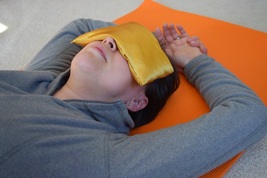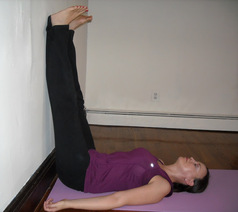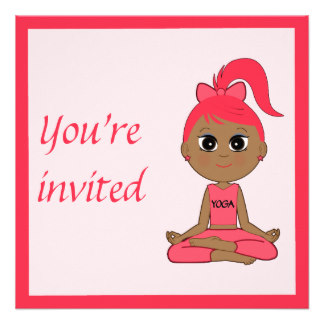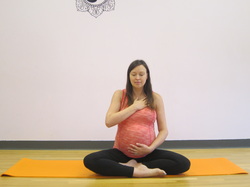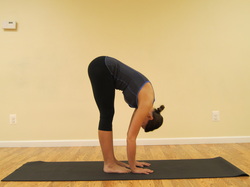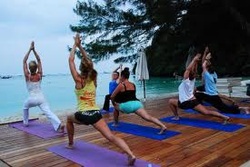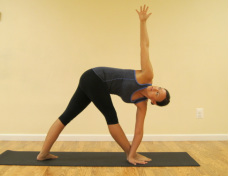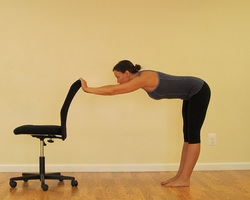You will find that with the use of a yoga strap that your range of motion increases allowing you to ease into more advanced poses while still maintain correct alignment. A yoga strap also provides support and stability in a pose, thereby preventing injury.
Many students also find that using a yoga strap helps them reach a specific yoga posture with less effort and in a faster time frame.
Overall, if you are stiff, recovering from an injury, or just want to maintain structural body alignment, a yoga strap is an inexpensive prop that adds great value to your practice.
Types of Yoga Straps
The main difference between yoga straps tends to be the length, material, and buckle. Typically, yoga straps are available in lengths of 6 feet, 8 feet, and 10 feet in a durable cotton with either a plastic or metal buckle.
When selecting a yoga strap, keep in mind that the longer it is, the more slack there will be in the strap. Even if you are shorter in height, it doesn’t always mean that you want to go with the shorter strap. For instance, if you plan on using the strap for aligning the shoulders and back, take in to account that you will need to be able to comfortably wrap the strap around your midline, over your shoulders, and cross it around your back. Of course, you can always tie two straps together to create additional length, if necessary.
Poses to Try with Your Yoga Strap
After warming up with a few sun salutations, pick up your yoga strap and give these postures a go:
Seated Lateral Flexion: Sit in Sukhasana or any comfortable cross-legged position. Hold the strap with both hands raised overhead, shoulder-width apart with little to no slack in the strap. Keeping a firm grip on the strap, tilt the side of your torso to the right. Take a few slow breaths, then slowly tilt to your left for another few slow breaths.
Bound Angle (Baddha Konasana) with Jet Pack: While you are still seated on the floor, center the yoga strap horizontally, just under the shoulder blades, then take both ends of the strap under the arms and sling the ends up and over the top of the shoulders. Cross the strap at the back so it forms an “X,” then bring both strap ends back around the torso and buckle in the front. Press the soles of the feet together so the knees turn out to the sides and hinge forward from the hips. The strap will improve your posture and ensure that you keep your chest open.
Triangle Pose (Trikonasana): Keep the strap in the same position crossed behind the back as instructed above, then stand up and separate your feet about 3 feet apart. Turn the right foot out to a 90 degree angle and the back left foot in to a 45 degree angle. With both arms extended out to the sides, push the left hip back towards the left ankle and bring the right side of your torso in line with the right knee. The strap will help keep shoulders opening so that the side of the body is in one plane. Repeat on the other side.
Extended Hand to Big Toe Hold (Utthita Hasta Padangustasana): Buckle the strap around the sole of your right foot, centering the strap at the arch of the foot. Hold on to the strap with the right hand. Then, lift your right leg up as high as you can while keeping the raised leg straight. The strap acts as an extension of the arms, if you aren’t able to hold on to the big toe of with the leg extended straight out in front of you. Even if you are able to easily hold on to the big toe, you may want to experiment with using the strap so that it is possible to gently lift the leg higher into the air. Repeat on the other side.
Reclining Bound Angle (Supta Baddha Konasana): From a seated position on the floor, press the soles of the feet together so the knees turn out to opposite sides. Center the strap behind your lower back and hold on to the ends of the strap with each hand. Guide the ends of the strap over the tops of the legs. Thread it over the ankles at first, then slide it underneath the ankles and buckle it so that the buckle is slightly above the side of the lower leg for comfort (anywhere so you don’t feel discomfort from the buckle pressing into the legs is fine). Now, slowly lie back on to the mat. The strap will bind your legs in place so that the feet won’t slip down the mat. The strap keeps the tension in the legs while giving you a feeling of support.
Reclining Hand to Big Toe Hold (Supta Padangustasana): Lying on the mat in a supine position, bring your right knee into your chest. Buckle the strap around the center of your right sole in a tight yet comfortable loop. Then, extend your right leg straight up so that the sole of the right foot is facing the ceiling. Left leg is straight (modification: bend the left knee). Here, the strap acts as an extension of the arms, if you are unable to hold on to the big toe with just the index and middle finger while keeping the leg straight. Even if you do have the range of motion to hold on to the big toe with a straight leg, you may want to use the strap to gently ease the leg closer to your head. Now, take the free end of the strap underneath the shoulder blades and pull it straight out to the left side. Keeping the left arm extended, use the strap as a pulley system to guide the right leg closer to the torso. Repeat with the left leg.
Cow Face Pose (Gomukhasana): Start in a seated position on the mat with your legs extended out in front. Bend the right knee into the body, then place the right foot on the outside of the left thigh on the floor. Bend the left knee and place the right knee on top of the left knee. Keep both sit bones grounded on the floor. With the strap in your left hand, raise your left arm overhead and bend the left elbow. Take the right arm behind the back and catch strap with the right hand. Begin to inch the hands along the strap until it is possible to claps both hands. In this case, the strap can really help you make progress if your shoulders are tight. Repeat on the other side. For a modification to Cow Face Pose (Gomukhasana): sit in Easy Cross-legged Posed (Sukhasana)
King Dancer (Natarajasana): From a standing position, hold the strap in both hands and step the right foot on top of the strap on the floor. Cross the strap in front of you. Step the left foot through the loop like your would with a jump rope. Bend the right knee and pull on the strap with both hands to lift the back right leg toward the head. Repeat on the other side. Since this posture involves balancing, you might want to stand so that the side of the body is near a wall.
There are a lot of other yoga poses that you can employ the yoga strap with, but the ones listed above are a great introduction. Remember, yoga straps aren’t just used for easing into poses – they can also offer a more challenging tension. If you have reached a plateau in your practice or just don’t feel challenged, try adding a yoga strap to the mix and enjoy the new experience.
Follow us on Facebook and Twitter. For yoga in Dunellen, NJ or yoga in Piscataway, NJ and yoga in other Central New Jersey areas, get in touch with me at Yoga Destiny.
